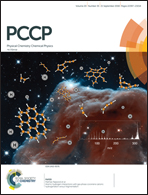Ferro- or antiferromagnetism? Heisenberg chains in the crystal structures of verdazyl radicals†
Abstract
In this study, we address the question of the origin of ferromagnetic or antiferromagnetic interactions in alkynyl-substituted 1,5-diphenyl-6-oxo verdazyl radicals. While a TMS-alkynyl derivative (3) shows antiferromagnetic ordering at low temperatures, the corresponding deprotected alkynyl verdazyl (4) shows ferromagnetic interactions. For both compounds, magnetic Heisenberg chains are characteristic, which were studied systematically by means of X-ray crystallography and quantum chemical calculations. Ferromagnetic interactions are rarely found in such radicals. Therefore, uncovering such structure–property relationships is of crucial importance in order to understand and design promising ferromagnetic networks. Using this knowledge, we were able to design and crystallize diyne derivatives showing comparable solid state characteristics and therefore antiferro- and ferromagnetic Heisenberg chain structures. We show that the understanding of such property–structure relationships is adequate for the design of organic–magnetic materials with defined cooperative effects within the class of verdazyl radicals.



 Please wait while we load your content...
Please wait while we load your content...